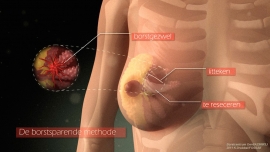Breast-conserving procedure
What is it?
What is it?The tumour is removed along with some of the surrounding breast tissue to make sure that all the malignant cells present the tumour are also removed. Radiation therapy is always necessary after this operation to reduce the risk of new tumour formation in the remaining breast tissue.
Due to the poor aesthetic result, a breast-conserving procedure is not suitable if the tumour is too big in relation to the breast. It is best to refrain from breast-conserving surgery if more than one tumour is present in the breast. This is also the case if pre-cancerous cells are found around the tumour in extensive numbers. In this case, there is an increased risk that the tumour will grown again after the breast-conserving treatment.

If the tumour is not palpable , the surgeon has a guide wire placed in the breast with a small barb (= harpoon) by the radiologist beforehand. Oncoplastic volume displacement is one of the latest trends. This involves the detachment of the bordering glandular tissue under the skin. The edges of the glandular tissue are moved toward each other and secured. This avoids a cavity in the breast in many cases.
Possible risks
Possible risksPlease note! As the glandular tissue must be detached during the procedure, the breast may feel harder after the procedure and the recovery process may last longer. There is an associated slightly increased risk of inflammation.
Centres and specialist areas
Centres and specialist areas
Latest publication date: 16/05/2024
Supervising author: Dr Elzo Kraemer Ximena






